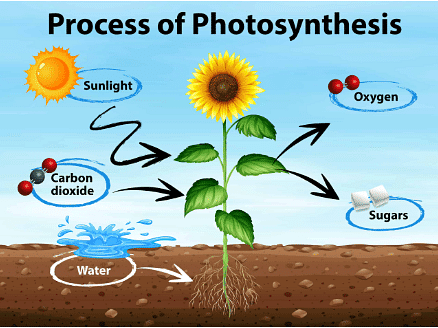Class 9 Exam > Class 9 Notes > Year 9 Biology (Cambridge) > Photosynthesis and plant growth
Photosynthesis and plant growth | Year 9 Biology (Cambridge) - Class 9 PDF Download
Photosynthesis
- Photosynthesis is the process by which green plants, algae, and some bacteria convert light energy into chemical energy stored in glucose.
- Process: Chlorophyll in plant cells absorbs light energy, which is used to split water molecules into oxygen and hydrogen. The oxygen is released as a byproduct, and the hydrogen combines with carbon dioxide to form glucose.
- Example: In a garden, plants like roses undergo photosynthesis to produce sugars from sunlight, which they use for growth and flowering.

Plant Growth
- Plant growth is a dynamic process influenced by various environmental factors and internal mechanisms.
- Environmental Factors: Factors such as light intensity, temperature, water availability, and nutrient levels play crucial roles in plant growth.
- Example: Plants in a greenhouse grow faster due to controlled conditions that optimize factors like temperature and light.
- Internal Mechanisms: Hormones like auxins and gibberellins regulate plant growth, influencing processes such as cell elongation and fruit development.
- Example: In tomato plants, gibberellins help in fruit enlargement, affecting their growth and development.

Question for Photosynthesis and plant growthTry yourself: Which environmental factor plays a crucial role in plant growth?View Solution
Transport of Water and Mineral Salts in Plants
- Plants absorb water and mineral salts from the soil through their roots and transport them to the rest of the plant.
- Root Structure: Root hairs and the root cortex increase the surface area for water absorption and facilitate the movement of minerals.
- Example: Trees like oak trees have deep root systems that allow them to access water deep underground, helping them survive dry conditions.
- Transport Mechanism: Water moves through the plant via the xylem, driven by transpiration and cohesion-tension mechanisms.
- Example: Cut flowers placed in a vase absorb water through their stems, demonstrating how water transport sustains plant tissues.

Conclusion
- Understanding the processes of photosynthesis and plant growth, as well as the transport of water and minerals, is essential for comprehending the biology of plants and their role in ecosystems.
- Ecological Impact: Photosynthesis not only provides energy for plant growth but also produces oxygen, which is vital for the survival of other organisms.
The document Photosynthesis and plant growth | Year 9 Biology (Cambridge) - Class 9 is a part of the Class 9 Course Year 9 Biology (Cambridge).
All you need of Class 9 at this link: Class 9
|
9 videos|14 docs|4 tests
|
FAQs on Photosynthesis and plant growth - Year 9 Biology (Cambridge) - Class 9
| 1. How does photosynthesis contribute to plant growth? |  |
Ans. Photosynthesis is the process by which plants convert sunlight into energy to produce glucose, their main source of food. This glucose is used by the plant for growth, repair, and reproduction, making photosynthesis essential for plant growth.
| 2. What are the key factors that affect plant growth through photosynthesis? |  |
Ans. Some key factors that affect plant growth through photosynthesis include the availability of sunlight, carbon dioxide, water, and nutrients. A lack of any of these factors can limit the plant's ability to photosynthesize and grow effectively.
| 3. How does the process of photosynthesis work in plants? |  |
Ans. In photosynthesis, plants use chlorophyll and other pigments to capture sunlight energy. This energy is used to convert carbon dioxide and water into glucose and oxygen. The glucose is then used as energy for the plant, while the oxygen is released into the atmosphere.
| 4. Can plants grow without photosynthesis? |  |
Ans. No, plants cannot grow without photosynthesis. Photosynthesis is the primary way in which plants produce the energy they need to grow and survive. Without photosynthesis, plants would not be able to produce the glucose they need for growth and development.
| 5. How can we optimize plant growth through photosynthesis? |  |
Ans. To optimize plant growth through photosynthesis, it is important to provide plants with adequate sunlight, water, carbon dioxide, and nutrients. Additionally, ensuring proper plant care, such as proper watering and fertilizing, can help support healthy photosynthesis and promote optimal plant growth.
Related Searches
















